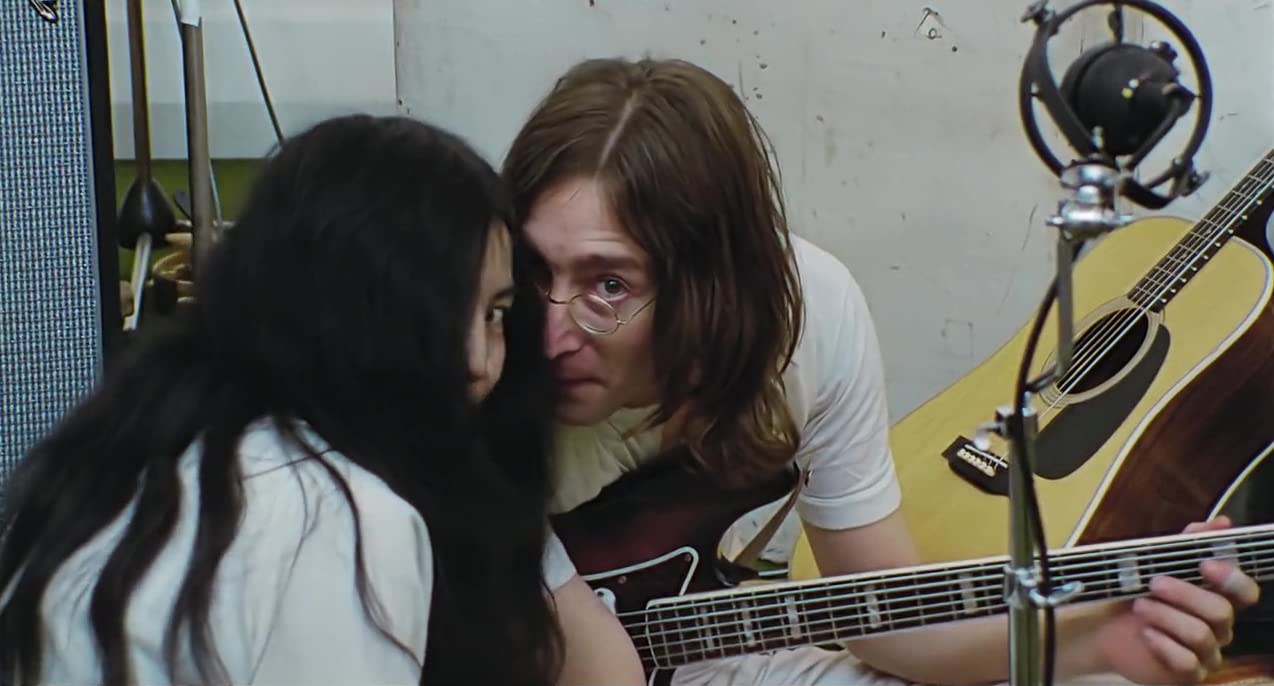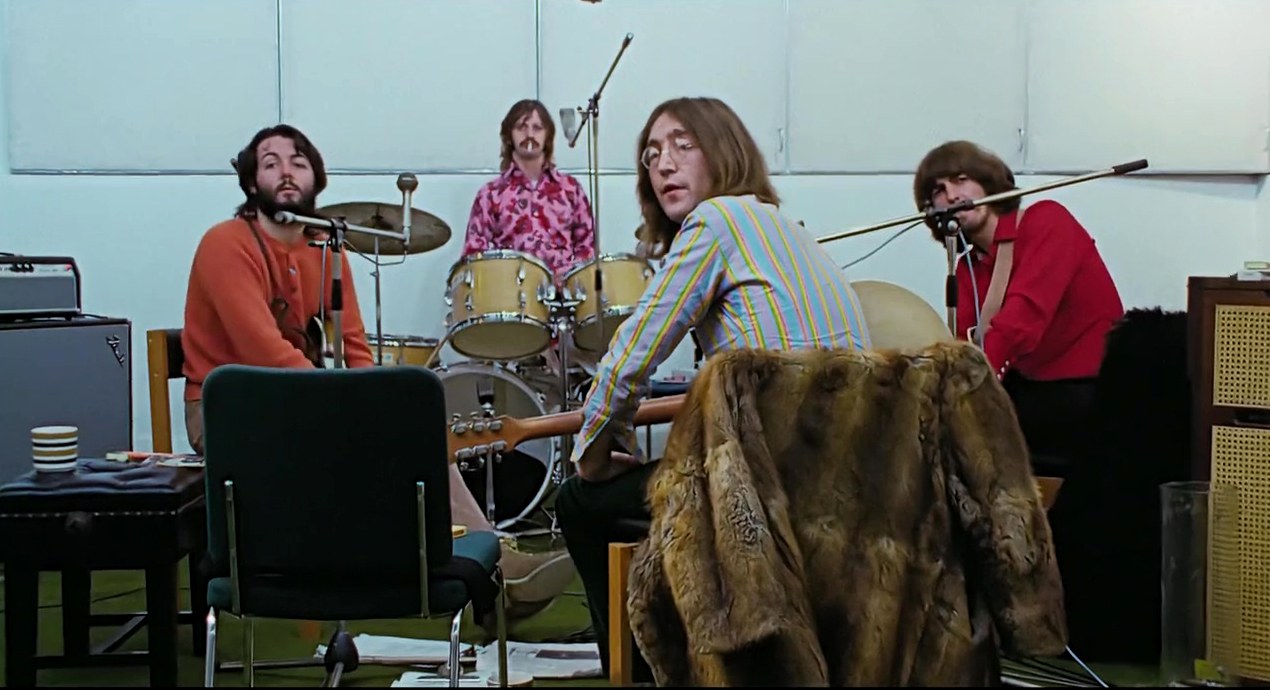Disney’s docuseries “The Beatles: Get Back,” has been nominated for five Emmys. Filmmaker Peter Jackson received a nod for directing it, and another entry for Outstanding Documentary or Nonfiction Series, along with co-producers Paul McCartney and Ringo Starr – the two-living members of the band – as well as John Lennon and George Harrison’s widows, Yoko Ono Lennon and Olivia Harrison.
In the series, Jackson gives an in-depth, behind the scenes view of Michael Lindsay-Hogg’s 80-minute, 1970 documentary “Let It Be,” whose nearly 60 hours of film footage shot in 1969 and recorded over 150 hours of audio. The studio recordings were locked in a vault for 50 years. Jackson and his team accessed the material, and by applying film restoration techniques, they created a nearly 8-hour, three-part series of The Beatles making their twelfth studio album. The band had 21 days to record and rehearse for a live concert, which culminated with the band’s famous 42-minute performance at the Apple Corps building’s rooftop in London on January 30, 1969 – the last time The Beatles played live together.
Now the award-winning director discusses what led him to pursue this project, which took four years to complete, and how it morphed from being a feature film into a series.
Jackson: “I can talk about The Beatles till the cows come home.”
When Jackson was 11 years old, he started saving money to buy a model plane. He got a newspaper route and sold some mushrooms on the side of the road for about “two bucks a bag.” After a few weeks, he had saved up enough, so he went into town to get the aircraft replica. On the way, he passed a record shop’s window and saw the just released The Beatles’ greatest hits, compiled into red (1962-1966) and blue (1967-1970) albums.
“[The red album] had the photograph of them when they were young on the staircase, and the blue album had the older hairy guys, and my attention was immediately grabbed by those two photos,” Jackson recalls. “I went into the shop, picked up the albums and looked at them. I recognized some of the songs, but didn't know much about them, so I abandoned the idea of a little model plane, and bought my first Beatles albums in 1972-73.”
For 40 years, he’s been a fan, Jackson says, so it’s easier to give interviews about the band.
“‘Lord of the Rings’ and ‘The Hobbit’ and ‘King Kong:’ and all those, you get a bit tired of talking about [them],” he declares. “But I can talk about The Beatles till the cows come home.”
A labor of love
After visiting Apple Corps – the multi-armed, multimedia corporation founded by The Beatles in London – Jackson was given access to hundreds of hours of the archival footage and audio stemming from the 1970 documentary “Let It Be.”
He then proceeded to view and edit the footage. “If you're making an 80-minute film, as opposed to a seven and a half hours film, you've got two very different beasts that you're dealing with,” he explains.
Jackson and his team spent almost four years on the project. “I probably ended up spending two years longer on it than I thought I was. Who cares?” he asks, adding that money was not the primary incentive behind the project. “I didn't get paid more or less. It was a great experience.”
Apple Corps financed 100% of the project, which throughout the process, aided Jackson. “They're actually the best studio I've ever worked for,” Jackson states. “If I wanted to ask Paul [McCartney] a question, [within] minutes, he'd get back to me.”
Feature film vs. series
With the movie underway, Jackson along with Apple Corps’ CEO Jeff Jones started shopping for a distributor. On the eve of the pandemic, Disney picked it up and they agreed it would be a feature film of two and half hours. Then, they set a theatrical release date for October 2021.
Once the pandemic hit, Disney delayed the project. “There was a period where all the studios were just freezing the movies and pushing them back, so we got caught up in that,” Jackson says. He and editor Jabez Olssen continued working on the film from New Zealand.
“If the pandemic hadn't happened, we would have delivered a feature film,” he says, but because they had more time to cut, [we] kept adding “these little gems and nuggets” to it.
When they were done, the film was six-and-a-half hours long, which they felt was the best way to tell the story. Then, they sent the first cut to McCartney and Starr, because “The Beatles always had the first look at things,” he explains. They all agreed to the format, and Jackson says he went to Disney to break the news that this would have to be a series.
To Jackson’s delight, former Disney CEO Bob Iger “turned out to be a massive Beatle fan” and accepted the change, setting up the series to be streamed on Disney+. “It makes a difference if you're landing on it with a company where there's a genuine love for the subject.”
“Don’t change a thing.”
Every now and then, during the editing process, Jackson says he would find a five-minute scene and send it to McCartney, Starr, Olivia Harrison, or Sean Lennon to check on something, or find out who was in the footage, or what was going on there.
“Paul McCartney said to me at the very beginning, ‘It's your film, do what you want’,” Jackson notes.
But during his consultation with director Lindsay-Hogg, Jackson found out that the making of “Let It Be” on July 20, 1969 – turned out to be a little bit of a nightmare for The Beatles. The band members exerted considerable control over what would and would not be included in that film.
“One of The Beatles would come in the cutting room the next day and get them to change stuff. And then, the day after, another Beatle would show up and get him to put all the other stuff,” Jackson reveals.
“The Lord of the Rings” filmmaker says he was expecting to get pilot notes and comments on the film as well.
“I didn't get one note, not one,” he affirms. “The only comment I got was, ‘This is the most stressful thing that I've ever watched in my life. But don't change a thing’.”
Now Jackson says he realizes that enough time has gone by that the remaining Beatles can probably see this film as a historical documentary.
Going Yoko Ono blind
During the recording and rehearsing sessions of “Let It Be,” Yoko Ono would sit next to the band and read, do crossword puzzles, or knit while they created, an act that even Jackson found distracting at first.
“The strange thing [is] this movie was cut over four years and I became Yoko blind,” he says. “The first time I watched it, I was so distracted by Yoko sitting there. It was so distracting that by the time I got into year two or year three of watching it, I couldn't see her anymore. I became completely bonkers.”
Though she was breaking a Beatles rule that girlfriends should not be in the studio with them, Jackson says she was not intrusive.
“The truth is, she never gives them notes on their performance. She never tries to intrude,” he remarks.
Today, Yoko says John asked her to be there. “Yoko and John had quite a late term miscarriage in [November 1968], so they were both in a state of grief,” he explains. “The alternative is that John comes into the studio, and Yoko just stays at home all by herself. So I could understand the two of them wanting to complete each other at that point in time.”

“The first time I watched it, I was so distracted by Yoko sitting there. It was so distracting that by the time I got into year two or year three of watching it, I couldn't see her anymore,” says Peter Jackson. John Lennon and Yoko Ono in the studio during the recording of the album “Let It Be.” Photo courtesy of Apple Corps.
Amazon’s “The Lord of the Rings” series
Jackson says he doesn’t have anything to do with Amazon’s “The Lord of the Rings: The Ring of Power” series, though he was contacted five years ago to see if he’d be interested in being a showrunner or directing episodes. When he asked to read a script first, he was told they didn’t have one yet, but would send one as soon as they did.
“I was waiting for the scripts to arrive and they never did,” he affirms.
However, he says he’s looking forward to watching it. “The one thing with the ‘Lord of the Rings’ films is: I was a person that could never actually watch them,” he says. “So I've deliberately tried to not learn too much about this, because I'm actually looking forward to being able to just sit back and then see it.”
In retrospect, Jackson says if he were involved with the series, he wouldn’t have been able to work on The Beatles project.

“There’s something very poignant and emotional about getting your hands on footage that somebody else has shot and taking the responsibility of trying to do something with that footage,” Peter Jackson explains. Paul McCartney (left), Ringo Starr, John Lennon and George Harrison during the recording of the album “Let It Be.” Photo courtesy of Apple Corps.
Being a documentarian
Jackson says he loves documentaries. “There’s something very poignant and emotional about getting your hands on footage that somebody else has shot and taking the responsibility of trying to do something with that footage,” he explains.
In his documentary “They Shall Not Grow Old,” Jackson says he didn’t have the cameraman to discuss his shots, but for “The Beatles: Get Back” he was able to contact director Lindsay-Hogg, whom he became good friends with.
“I would constantly be phoning him up and saying, ‘Michael, on day seven, you did a shot with the camera’ and most of the time, he could remember what I was talking about,” he explains. “So I was able to talk to Michael and ask him some questions and what he had in mind at certain times.”
While not shying away from the tensions that would eventually drive The Beatles apart, the series celebrates the band’s joyful and playful moments. And with Lindsay-Hogg’s assistance, Jackson says his main goal with the docuseries was to honor the footage that was shot.
“People keep talking about Michael's film, which was a product of its time and of the stresses that were put, not just on him, but on the band. So a lot of people write about that,” he points out. “But what they don't really say is that every single frame of the film ‘Get Back’ was shot by Michael.”
What’s next?
Jackson explains that though he still has five-to-six hours of “fantastic material” he didn’t include in this film, there may not be a market for extended cuts anymore. However, there’s some talk with Disney and Apple Corps about what to do with the unused footage.
“I don't want it to go back in the vault for another 50 years,” he declares. “So, it's a conversation that's happening, but it's not necessarily a definitive one at this point.”
For now, fans can watch “The Beatles: Get Back” on Disney+.
